202. So the culmination of Sirius
(at 21h according to my assumed era for rongorongo) defined
where one half of the year was beginning and that of
Wega was where the other (primordial) half of the year had begun.
... Allen has documented all his star culminations at 21h, which
could be due to an effort of keeping the culminations at their
proper places according to the ancients, 24h (spring equinox) -
21h = 3h = 24h / 8 = 45º. 3h corresponds to 366 / 8 = 45.75 of
my right ascension days and *366 - *46 = *320 (Dramasa,
σ
Octantis) ...
... It is an interesting fact, although
one little commented upon, that myths involving a canoe
journey, whether they originate from the Athapaskan and
north-western Salish, the Iroquois and north-eastern
Algonquin, or the Amazonian tribes, are very explicit about
the respective places allocated to passengers. In the case
of maritime, lake-dwelling or river-dwelling tribes, the
fact can be explained, in the first instance, by the
importance they attach to anything connected with
navigation: 'Literally and symbolically,' notes Goldman ...
referring to the Cubeo of the Uaupés basin,
'the river is a binding thread for the people. It is a
source of emergence and the path along which the ancestors
had travelled. It contains in its place names genealogical
as well as mythological references, the latter at the
petroglyphs in particular.' A little further on ... the same
observer adds: 'The most important position in the canoe are
those of stroke and steersman. A woman travelling with men
always steers, because that is the lighter work. She may
even nurse her child while steering ... On a long journey
the prowsman or stroke is always the strongest man, while
a woman, or the weakest or
oldest man is at the helm
...
... After the great flood had at long last
receded, Raven had gorged himself on the delicacies left by the
receding water, so for once, perhaps the first time in his life,
he wasn't hungry. But his other appetites, his curiosity and the
unquenchable itch to meddle and provoke things, to play tricks
on the world and its creatures, these remained unsatisfied.
Raven gazed up and
down the beach. It was pretty, but lifeless. There was no
one about to upset, or play tricks upon. Raven sighed. He
crossed his wings behind him and strutted up and down the sand,
his shiny head cocked, his sharp eyes and ears alert for any
unusual sight or sound. The mountains and the sea, the sky now
ablaze with the sun by day and the moon and stars he had placed
there, it was all pretty, but lifeless. Finally Raven cried out
to the empty sky with a loud exasperated cry. And before the
echoes of his cry faded from the shore, he heard a muffled
squeak. He looked up and down the beach for its source and saw
nothing. He strutted back and and forth, once, twice, three
times and still saw nothing. Then he spied a flash of white in
the sand. There, half buried in the sand was a giant clamshell.
As his shadow fell upon it, he heard another muffled squeak.
Peering down into the opening between the halves of the shell,
he saw it was full of tiny creatures, cowering in fear at his
shadow. Raven was delighted. Here was a break in the monotony of
the day. But how was he to get the creatures to come out of
their shell and play with him? Nothing would happen as long as
they stayed inside the giant clamshell
...
... The divine first appears abstractly,
as generative-spirit-in-itself. Only after seven epochs of
the po, the long night of the world's
self-generation, are the gods as such born - as siblings to
mankind. God and man appear together, and in fraternal
strife over the means of their reproduction: their own older
sister. Begun in the eighth epoch of creation, this struggle
makes the transition to the succeeding ages of the ao,
the 'day' or world known to man. Indeed the struggle is
presented as the condition of the possibility of human life
in a world in which the life-giving powers are divine. The
end of the eighth chant thus celebrates a victory: 'Man
spread about now, man was here now; / It was day [ao].' And
this victory gained over the god is again analogous to the
triumph achieved annually over Lono at the New Year,
which effects the seasonal transition, as Hawaiians note,
from the time of long nights (po) to the time of long
days (ao). The older sister of god and man,
La'ila'i, is the firstborn to all the eras of previous
creation. By Hawaiian theory, as firstborn La'ila'i
is the legitimate heir to creation; while as woman she is
uniquely able to transform divine into human life. The issue
in her brothers' struggle to possess her is accordingly
cosmological in scope and political in form. Described in
certain genealogies as twins, the first two brothers are
named simply in the chant as 'Ki'i, a man' and 'Kane,
a god'. But since Ki'i means 'image' and Kane
means 'man', everything has already been said: the statuses
of god and man are reversed by La'ila'i's
actions. She 'sits sideways', meaning she takes a second
husband, Ki'i, and her children by
the man Ki'i
are born before her children by the god Kane ... In
the succeeding generations, the victory of the human line is
secured by the repeated marriages of the sons of men to the
daughters of gods, to the extent that the descent of the
divine Kane is totally absorbed by the heirs of
Ki'i ...
|
JAN 19
(384 = 13 * 29½ + ½) |
20 |
21 |
 |
 |
 |
|
Gb3-14
(75
→
182 - 107) |
Gb3-15 |
Gb3-16 (229 + 77
= 306) |
 |
 |
 |
|
Gb7-1
(182 = 265 -
183) |
Gb7-2 (229 + 183
= 412) |
Gb7-3
(413 → 14 *
29½) |
|
PLACE OF THE SUN: |
|
σ
Andromedae (3.0),
ι Ceti (3.3), ζ Tucanae (3.5), ρ Andromedae, π
Tucanae (3.7) |
No
star listed (4) |
ANKAA =
α
Phoenicis,
κ Phoenicis (5.0)
ALPHARD (α Hydrae) |
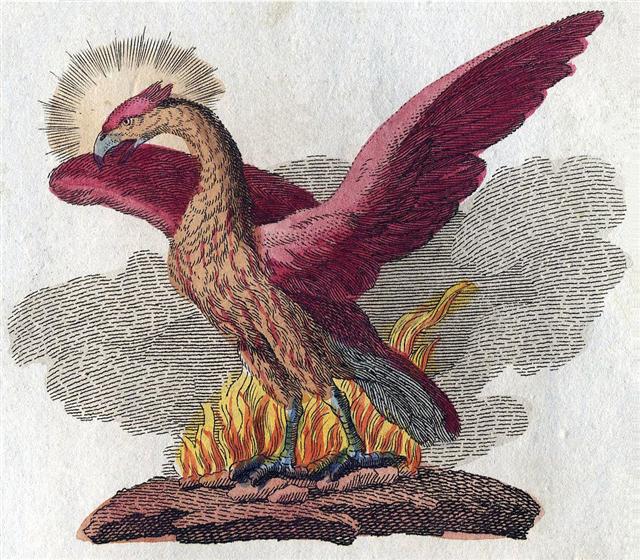 |
|
March 24 (*3,
*368) |
3-25 (84, Julian equinox) |
26 (365 + 85 =
450, *370) |
|
°March 20 (*364) |
0h |
22 (81) |
|
'Febr 25 (*341) |
26 (422) |
27 (58) |
|
"Febr 11 (*327) |
12 (408) |
13 (*329) |
|
THE
NAKSHATRA VIEW: |
|
JULY 20 (201 = 19
+ 182) |
21 |
22 → 22 / 7 →π |
|
Hasta-13 (Hand)
/
Chariot-28 (Worm)
GIENAH (Wing) = γ Corvi (185.1),
ε
Muscae (185.2),
ζ
Crucis (185.4),
ZANIAH (Corner) =
η
Virginis
(185.9)
*144.0 = *185.4 - *41.4 |
CHANG SHA (Long
Sand-bank) = ζ Corvi
(186.3) |
INTROMETIDA (Inserted) =
ε
Crucis (187.4),
ACRUX =
α
Crucis
(187.5)
*146.0 = *187.4 - *41.4 |
|
Equinox |
Sept 23 (266) |
24 (*187) |
|
°Sept 18 (261 → 9 * 29) |
19 |
20 (*183) |
|
'Aug 26 (*158 =
*185 - *27) |
27 |
28 (*160) |
|
"Aug 12 (*144 =
*185 - *41) |
13
(225) |
14 (*146) |
 |
 |
 |
|
Ga5-11 (121 → May 1,
121) |
Ga5-12 |
Ga5-13 (123 = 306
- 183) |
 |
The birth of the primordial half of the year could evidently
be observed at the place for
the night of "August 13 (225) corresponding to the current
date September 23 (266
= 225 + 41). I.e., the Raven constellation would come 41 days later
than where it anciently (in the era of Bharani) had arrived.
... the bird, being sent with a cup for
water, loitered at a fig-tree till the fruit became ripe,
and then returned to the god with a water-snake in his claws
and a lie in his mouth, alleging the snake to have been the
cause of the delay. In punishment he was forever fixed in
the sky with the Cup and the Snake; and, we may infer,
doomed to everlasting thirst by the guardianship of the
Hydra over the Cup and its contents. From all this came
other poetical names for our Corvus - Avis Ficarius,
the Fig Bird; and Emansor, one who stays beyond his
time; and a belief, in early folk-lore, that this alone
among birds did not carry water to its young ...
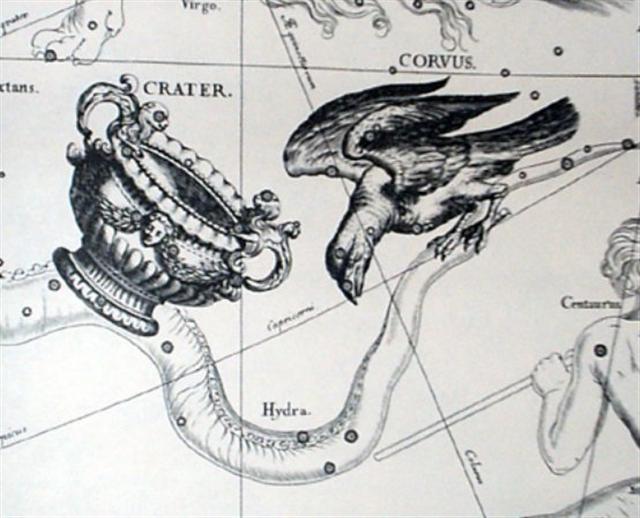
The era of Bharani (*41.4) was in turn *27 right ascension
nights behnd that for Aldebaran (*68)
→ the First Point of
Taurus:
|
*27 |
First Point
of Aries |
107 |
April 17 |
|
*68 |
Aldebaran |
148 |
"April 17 |
... number 27 identifies Bharani with Beltane, and *41.4 -
*26.6 (Polaris) = *14.8 (→
148) ...
The structure seems to have remained more or less the same while the times rolled on.

|
Phase
of Venus |
Observed periods |
Periods in the Mayan 'map' |
Difference |
|
Evening star |
263 |
250 |
- 13 |
|
Black |
8 |
8 |
0 |
|
Morning star |
263 |
236
= 8 * 29½ |
- 27 |
|
Black |
50 |
90 |
+ 40 |
|
Sum |
584 |
584 |
0 |
 |
In other words, the 'First Point of Venus' (as Morning
star) should be at the date April 17 according to its proper
era.

We could then try to move on beyond Aldebaran (*68) and add
a further *27 right ascension days. And this would
bring us to right ascension day *95
→ the 'First
Point of
Argo Navis' → Canopus.
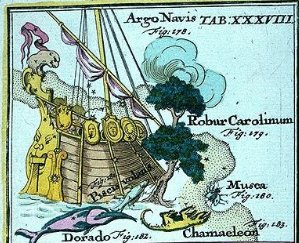
175 (Canopus) - 115 (ξ
Arietis) = 60.
→ *365 - *285 →
March 21 - December 31.
...
Currently, according to my assumed era for rongorongo, the
Point to watch was evidently defined by heliacal
ξ
Arietis:
|
 |
*225
|
 |
*107 |
 |
|
Ga2-1 (80 + 31 =
111) |
Gb4-16 (336 ↔ 4 *
84) |
Gb8-2 (443 = 229
+ 2 * 107) |
|
CANOPUS (*95) |
305 |
Ξ ARIETIS (*400, *35) |
0 |
Ξ ARIETIS (*400,
*35) |
|
St John's Day
(175 → 350 / 2) |
April 25
(480, 115) |
April 25
(480, 115) |
 
|
Leader:
Ringa pakia! Uma tiraha!
Turi whatia! Hope whai ake!
Waewae takahia kia kino!
Leader: Ka mate, ka mate
Team: Ka ora, ka ora
Leader: Ka mate, ka mate
Team: Ka ora, ka ora
All together :
Tēnei te tangata pūhuruhuru
Nāna nei i tiki mai whakawhiti te rā
Ā upane, ka upane
Ā upane, ka upane
Whiti te rā, hī! |
Leader: Slap the
hands against the thighs! Puff out the chest!
Bend the knees! Let the hip follow! Stamp the feet
as hard as you can!
Leader: ’Tis
death, ‘tis death (or: I may die)
Team: ’Tis life, ‘tis life (or: I may live)
Leader: ’Tis death, ‘tis death
Team: ’Tis life, ‘tis life
All together :
This the hairy man that stands here…
…who brought the sun and caused it to shine
A step upward, another step upward
A step upward, another step upward
The sun shines! |
|
It is death, it is
death: it is life, it is life; this is the man who
enabled me to live as I climb up step by step toward
sunlight. |

I have not listed the
culmination date for Canopus, but with the
culmination (at 21h) of Sirius at Gb2-8 we ought to
search around 6 glyphs earlier:
... Matua [A Taana]
said to Hotu [A Matua], 'Take along the
Hanau Eepe and let them work the land!' Hotu
called out to Heke: 'Go and bring the 500
prisoners on board the canoe!' He took all of them
along, led them on board the canoe, and left them there.
For six days (po ono), mats (moenga) were
taken on board the canoe (i.e., the loading of the canoe
took six days) ... [E:73-74]
By the way, the current date is
November 6 AD 2023.

 |
 |
 |
 |
 |
|
Gb2-6 (9 * 29) |
Gb2-7 |
Gb2-8 |
Gb2-9 (35) |
Gb2-10 (265) |
|
PLACE OF THE SUN |
BUNDA (Foundation)
/ KAKKAB
NAMMAΧ (Star of Mighty Destiny)
... β and ξ also
constituted the Persian lunar station Bunda
and the similar Coptic Upuineuti, the
Foundation; but β alone marked the sieu Heu,
Hiu, or Hü, Void, anciently Ko,
the central one of the seven sieu which, taken
together, were known as Heung Wu, the
Black Warrior, in the northern quarter of the
sky. It is found in Hindu lists as Kalpeny,
of unknown signification. On the Euphrates it
was Kakkab Nammaχ, the Star of Mighty
Destiny, that may have given origin to the title
of the manzil [Al Sa'd al Su'ud], as well
as to the astrologers' name for it - Fortuna
Fortunarum. Al Firuzabadi of Khorasan,
editor of Al Kāmūs, the great Arabic
dictionary of the 14th century, called some of
the smaller stars below this Al Au'ā, the
plural of Nau', a Star, but without
explanation, and they certainly are
inconspicious ...
|
|
Al Sa'd al Su'ud-22 (Luckiest of the Lucky)
/
Emptiness-11 (Rat)
TSIN = 36 Capricorni
(325.2),
ALPHIRK (The Flock) =
β
Cephei
(325.7),
SADALSUD =
β
Aquarii,
ξ
Gruis (325.9)
March
14 AD 2024 (Π) MARS |
No star listed (326) |
CASTRA =
ε
Capricorni
(327.2),
BUNDA (Foundation) =
ξ
Aquarii
(327.5)
SIRIUS (α Canis Majoris |
Mahar sha hi-na
Shahū-26 (Western One in the Tail of the Goat)
NASHIRA
(Fortunate One) =
γ
Capricorni
(328.0),
ν
Oct. (328.3),
AZELFAFAGE (Tail of the Hen) =
π¹
Cygni,
κ
Capricorni (328.7) |
Arkat sha hi-na
Shahū-27 (Eastern One in the Tail of the Goat)
ENIF (The Nose) =
ε
Pegasi, ERAKIS =
μ
Cephei
(329.2),
46 CAPRICORNI, JIH (the Sun) =
κ
Pegasi
(329.3),
ι Piscis Austrini (329.4),
λ
Capricorni
(329.6),
ν
Cephei (329.7),
DENEB
ALGIEDI
=
δ
Capricorni
(329.8)
*288.0 = *329.4 - *41.4 |
 |
|
Febr 9 (40) |
10 |
11 |
12 (408) |
13 (345 + 64) |
|
°Febr 5 (36) |
6 |
7 |
8 (*324) |
9 (40) |
|
'Jan 13 (378) |
14 |
15 (*300) |
16 |
17 |
|
"Dec 30 (364) |
31 |
"Jan 1 |
2 |
3
(368, *288) |
|
DEC 7 (11 * 31 =
341) |
8 |
9 |
10 |
11 (345) |
|
THE NAKSHATRA
VIEW: |
|
Al Tarf-7 (The End)
ψ
Velorum (143.3),
ALTERF =
λ
Leonis,
τ²
Hydrae (143.4),
ξ
Leonis (143.5)
*102.0 = *143.4 - *41.4 |
A
Hydrae
(144.1)
WEGA (α Lyrae) |
Creation of our present world
UKDAH (Knot) =
ι
Hydrae (145.4),
κ
Hydrae (145.5),
SUBRA =
ο
Leonis
(145.8)
ALPHEKKA MERIDIANA
*104.0 = *145.4 - *41.4 |
5 Imix 9 Kumk'u
Rishu A.-13 (Head of
the Lion)
ψ
Leonis (146.4),
RAS
ELASET AUSTRALIS = ε Leonis
(146.6)
*105.0 = *146.4 - *41.4 |
VATHORZ PRIOR = υ Carinae
(147.9) |
|
UKDAH (THE KNOT)
... σ,
4.6, was Ulug Beg's
Al Minhar al
Shujā', the Snake's Nose. τ¹,
4.9, flushed white, and τ²,
4.6, lilac, with ι and the
5th magnitude A, form the curve in the neck,
Ptolemy's Καμπή; but
Kazwini knew them as Ukdah, the Knot ... |
|
Aug 11 |
12 |
13 (225) |
14 |
15 (227) |
|
"July 1 |
2 |
3 (*104) |
4 |
5 |
|
JUNE 8 |
9 |
10 (161) |
11 |
12 |
 |
 |
 |
 |
 |
|
Ga3-20 → Dramasa |
Ga3-21 |
Ga3-22 |
Ga3-23 |
Ga3-24 |

... Midsummer is the flowering
season of the oak, which is the tree of endurance
and triumph, and like the ash is said to 'court the
lightning flash'. Its roots are believed to extend
as deep underground as its branches rise in the air
- Virgil mentions this - which makes it emblematic
of a god whose law runs both in Heaven and in the
Underworld ... The month, which takes its name from
Juppiter the oak-god, begins on June 10th and
ends of July 7th. Midway comes St. John's Day, June
24th, the day on which the oak-king was
sacrificially burned alive. The Celtic year was
divided into two halves with the second half
beginning in July, apparently after a seven-day
wake, or funeral feast, in the oak-king's honour ...
 |
Which points at "December 25 (the solstice day
corresponding to the Julian spring equinox date):
 |
 |
|
Gb1-26
(355
-
100) |
Gb2-1 (216
+ 40
= 256
→
8
*
32) |
|
PLACE
OF
THE
SUN |
|
21h
(319.6)
→
137.0
+
365.25
/ 2
=
319.6
ARMUS
= η
Capricorni
(319.0),
DORSUM
= θ
Capricorni
(319.3),
TSOO
= 24
Capricorni
(319.7) |
DRAMASA =
σ
Oct.,
χ Capricorni
(320.0),
ν
Aquarii
(320.3),
γ
Equulei (320.6),
ο
Pavonis (320.8) |
|
Febr
3
(399) |
4 (400
-
365
= 35) |
|
°Jan
30
(*315) |
31 (396) |
|
'Jan
7
(*292) |
8 (373) |
|
CHRISTMAS
EVE
(*278) |
"Dec 25 (359) |
|
DEC
1
(355
-
20) |
2 (336
→ 4
* 84) |
|
... only at the
evening of the solstitial days can spirits enter heaven, the
inhabitants of the northern parts of the island at one solstice,
the dwellers in the south at the other ...
According to the Julian calendar the spring
equinox was at day 84 ('March 25) and therefore we should
understand the corresponding winter solstice to be at 'December
25. 359 + (41 - 27) = 373 →
'January 8. |
|
THE NAKSHATRA
VIEW: |
|
9h
(137.0)
σ¹
Ursa
Majoris
(137.0),
κ
Cancri
(137.3),
τ
Cancri
(137.4),
ALSUHAIL
(al
Wazn,
of
the
Weight)
=
λ in
the
Vela
(Sail)
a part
of
Argo
Navis
(137.5),
σ²
Ursa
Majoris
(137.6),
τ
Ursa
Majoris
(137.7),
ξ
Cancri
(137.8)
*96.0
=
*137.4
-
*41.4 |
κ
in
the
Pyxidis
(Mariner's
Compass)
a part
of Argo
Navis
(138.0),
ε
(138.5) |
|
Aug
5 |
6
(218
=
400
-
182) |
|
"June
25
(217
-
41) |
26
(177
= 6
*
29½)
|
|
JUNE
2
(153
=
176
-
23) |
3
(218
-
64) |
 |
 |
|
Ga3-13 |
Ga3-14
(73
=
256
-
183) |
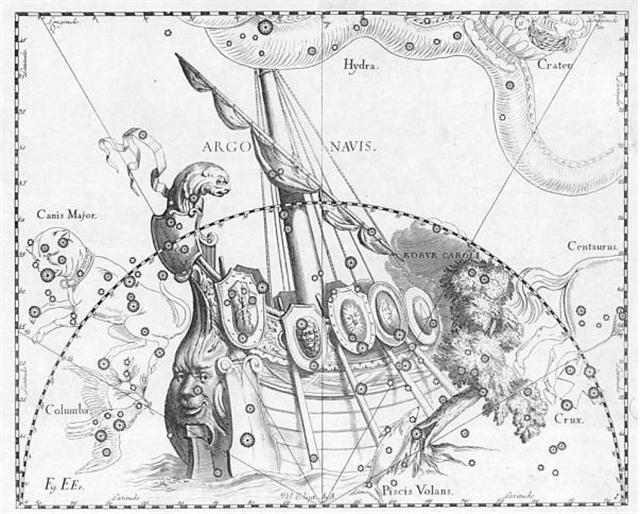
... According to a variety of
sources of the legend, the Argo was said to
have been planned or constructed with the help of
Athena. According to other legends it contained
in its prow a magical piece of timber from the
sacred forest of Dodona, which could speak
and render prophecies. Argo Navis is the only
one of the 48 constellations listed by the 2nd
century astronomer Ptolemy that is no longer
officially recognised as a constellation. It was
unwieldy due to its enormous size: were it still
considered a single constellation, it would be the
largest of all. In 1752, the French astronomer
Nicolas Louis de Lacaille subdivided it into
Carina (the keel, or the hull, of the ship),
Puppis (the poop deck), and Vela (the
sails). When Argo Navis was split, its Bayer
designations were also split. Carina has the
α, β
and ε, Vela has
γ and δ,
Puppis has ζ, and
so on. The constellation Pyxis (the mariner's
compass) occupies an area which in antiquity was
considered part of Argo's mast (called
Malus).
However, Pyxis is not now considered part of
Argo Navis, and its Bayer designations are
separate from those of Carina, Puppis
and Vela ... |
 |
 |
 |
 |
|
Gb2-2 |
Gb2-3 (29) |
Gb2-4 |
Gb2-5
(260) |
|
PLACE OF THE SUN |
|
α
Oct. (321.5),
δ
Equulei
(321.7),
Φ Capricorni
(321.8)
Febr
5 AD 2030 MARS |
KITALPHA (Part of a Horse) =
α
Equulei
(322.0),
ALDERAMIN (The Right Arm) = α Cephei
(322.9) |
DAI = ι Capricorni (323.5),
β
Equulei
(323.8) |
γ
Pavonis
(324.1),
YAN = ζ Capricorni
(324.6)
March
7 AD 2024 (66) MARS |
|
Febr 5 (36) |
6 |
7 (403) |
8 (*324) |
|
°Febr 1 |
2 |
3
(399) |
4 (*320) |
|
'Jan 9 |
10 (*295) |
11 |
12 (377) |
|
"Dec 25 (*280) |
26 |
27 |
28 (363) |
|
DEC 3 |
4 |
5 (339) |
6
(*260) |
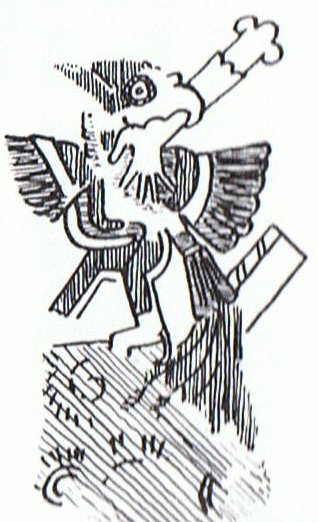 |
|
THE NAKSHATRA
VIEW: |
|
π
Cancri
(139.2),
MIAPLACIDUS =
β
Carinae
(139.3),
TUREIS (Little Shield) =
ι
Carinae
(139.8) |
No star listed (140) |
θ
Pyxidis,
MARKAB VELORUM =
κ
Velorum
(141.5),
AL MINHAR AL ASAD (The Nose of the Lion) = κ Leonis
(141.6),
λ
Pyxidis
(141.9) |
Star-25 (Horse)
/
ANA-HEU-HEU-PO-5 (Pillar where
debates were held)
ALPHARD (The Horse) =
α
Hydrae
(142.3),
ω
Leonis
(142.6),
τ¹ Hydrae
(142.7) |
|
Aug
7 |
8 (220) |
9 (*141) |
10 |
|
"June
27 |
28 |
29 (*100) |
30 |
|
JUNE 4 |
5 (156) |
6
(*77) |
7 |
 |
 |
 |
 |
|
Ga3-16 |
Ga3-17 |
Ga3-18 (77) |
Ga3-19 |
 |
|




























